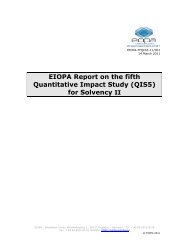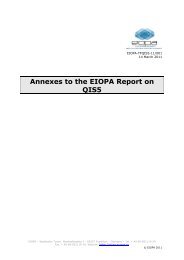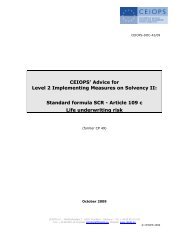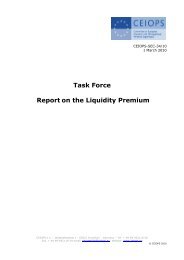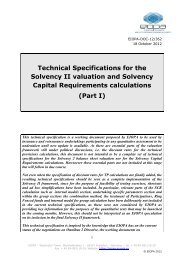Answers to the European Commission on the ... - Eiopa - Europa
Answers to the European Commission on the ... - Eiopa - Europa
Answers to the European Commission on the ... - Eiopa - Europa
Create successful ePaper yourself
Turn your PDF publications into a flip-book with our unique Google optimized e-Paper software.
Discounting<br />
7.22 The present value of <str<strong>on</strong>g>the</str<strong>on</strong>g> expected cash flows is equal <str<strong>on</strong>g>to</str<strong>on</strong>g> <str<strong>on</strong>g>the</str<strong>on</strong>g> value of an<br />
investment with identical cash flows <str<strong>on</strong>g>to</str<strong>on</strong>g> <str<strong>on</strong>g>the</str<strong>on</strong>g>se expected cash flows which<br />
will be paid with certainty. Such an investment replicates <str<strong>on</strong>g>the</str<strong>on</strong>g> expected<br />
cash flows of <str<strong>on</strong>g>the</str<strong>on</strong>g> liabilities. A more efficient way <str<strong>on</strong>g>to</str<strong>on</strong>g> arrive at this<br />
present value is via discounting. An undertaking’s insurance liabilities<br />
cash flows might be discounted using a term structure of interest rates<br />
which has <str<strong>on</strong>g>to</str<strong>on</strong>g> be based <strong>on</strong> <str<strong>on</strong>g>the</str<strong>on</strong>g> effective yields <strong>on</strong> default-free capital<br />
market instruments.<br />
7.23 A risk-free interest rate curve might be determined using <str<strong>on</strong>g>the</str<strong>on</strong>g> yield <strong>on</strong><br />
<str<strong>on</strong>g>the</str<strong>on</strong>g> highest quality government b<strong>on</strong>d issues available in <str<strong>on</strong>g>the</str<strong>on</strong>g> currency of<br />
denominati<strong>on</strong> of <str<strong>on</strong>g>the</str<strong>on</strong>g> liability. Where <str<strong>on</strong>g>the</str<strong>on</strong>g> risk-free yield cannot be<br />
determined with sufficient c<strong>on</strong>fidence (for example because l<strong>on</strong>g<br />
durati<strong>on</strong> b<strong>on</strong>d issues are not available in a particular currency) <str<strong>on</strong>g>the</str<strong>on</strong>g>n<br />
reference may be made <str<strong>on</strong>g>to</str<strong>on</strong>g> proxy measures, such as <str<strong>on</strong>g>the</str<strong>on</strong>g> swap curve.<br />
However, in such circumstances, <str<strong>on</strong>g>the</str<strong>on</strong>g>re should be appropriate<br />
adjustments for <str<strong>on</strong>g>the</str<strong>on</strong>g> differences observed between government b<strong>on</strong>d<br />
yields and <str<strong>on</strong>g>the</str<strong>on</strong>g> observed proxy yields.<br />
7.24 It may even be more efficient if <str<strong>on</strong>g>the</str<strong>on</strong>g> nominal term structure of interest<br />
rates for <str<strong>on</strong>g>the</str<strong>on</strong>g> various currencies in <str<strong>on</strong>g>the</str<strong>on</strong>g> EU is prescribed (such as <str<strong>on</strong>g>the</str<strong>on</strong>g><br />
Euro spot rate term structure). Various central banks already publish<br />
such term structures. This would allow insurers <str<strong>on</strong>g>to</str<strong>on</strong>g> value <str<strong>on</strong>g>the</str<strong>on</strong>g>ir liabilities<br />
using a prescribed term structure. Transparency is fostered by this<br />
method. If <str<strong>on</strong>g>the</str<strong>on</strong>g> capital market does not have <str<strong>on</strong>g>the</str<strong>on</strong>g> financial instruments<br />
available <str<strong>on</strong>g>to</str<strong>on</strong>g> replicate <str<strong>on</strong>g>the</str<strong>on</strong>g> l<strong>on</strong>ger term liabilities of insurers, prudent l<strong>on</strong>g<br />
term spot rates <str<strong>on</strong>g>to</str<strong>on</strong>g> arrive at a prudent extensi<strong>on</strong> <str<strong>on</strong>g>to</str<strong>on</strong>g> <str<strong>on</strong>g>the</str<strong>on</strong>g> market induced<br />
term structure of interest rates may be prescribed. Ano<str<strong>on</strong>g>the</str<strong>on</strong>g>r opti<strong>on</strong> is<br />
not <str<strong>on</strong>g>to</str<strong>on</strong>g> impose <str<strong>on</strong>g>the</str<strong>on</strong>g> discount rate <str<strong>on</strong>g>to</str<strong>on</strong>g> be used but <str<strong>on</strong>g>to</str<strong>on</strong>g> set principles for this<br />
rate, notwithstanding <str<strong>on</strong>g>the</str<strong>on</strong>g> possibility for <str<strong>on</strong>g>the</str<strong>on</strong>g> supervisor <str<strong>on</strong>g>to</str<strong>on</strong>g> advise <strong>on</strong> a<br />
market-related rate for a given book of business. This approach is likely<br />
<str<strong>on</strong>g>to</str<strong>on</strong>g> be more flexible in taking in<str<strong>on</strong>g>to</str<strong>on</strong>g> account capital market developments,<br />
but could have <str<strong>on</strong>g>the</str<strong>on</strong>g> effect that different insurance undertakings<br />
interpret <str<strong>on</strong>g>the</str<strong>on</strong>g> principles differently.<br />
7.25 However, valuing technical provisi<strong>on</strong>s with a risk–free interest rate<br />
curve may not allow for 'sufficient prudence' technical provisi<strong>on</strong>s (as<br />
expressed in CfA 7). It might weaken <str<strong>on</strong>g>the</str<strong>on</strong>g> positi<strong>on</strong> of policyholders, if<br />
<str<strong>on</strong>g>the</str<strong>on</strong>g> provisi<strong>on</strong>s plus margins for risk do not reach <str<strong>on</strong>g>the</str<strong>on</strong>g> present level of<br />
provisi<strong>on</strong>s. An alternative may be that <str<strong>on</strong>g>the</str<strong>on</strong>g> supervisor prescribes or<br />
approves <str<strong>on</strong>g>the</str<strong>on</strong>g> term structure including a margin of prudence <str<strong>on</strong>g>to</str<strong>on</strong>g> calculate<br />
<str<strong>on</strong>g>the</str<strong>on</strong>g> insurance liabilities. But using margins in <str<strong>on</strong>g>the</str<strong>on</strong>g> discount rate for<br />
valuing liabilities may not be a satisfac<str<strong>on</strong>g>to</str<strong>on</strong>g>ry means of achieving an<br />
explicit level of prudence. For example, using a discount rate of 60% of<br />
<str<strong>on</strong>g>the</str<strong>on</strong>g> yield of a specified b<strong>on</strong>d (an apparently explicit margin) in fact<br />
implies using varying implicit risk margins because <str<strong>on</strong>g>the</str<strong>on</strong>g> actual margin<br />
changes as interest rates change and is <str<strong>on</strong>g>the</str<strong>on</strong>g>refore not properly risk<br />
related.<br />
15






